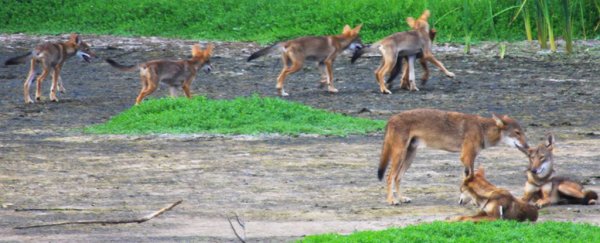From time to time, there are whispers that red wolves still roam parts of Texas. There shouldn't be any there – the animals were officially declared extinct in the wild roughly 40 years ago.
But a new discovery lends at least a skerrick of truth to some sightings, at least on Galveston Island on the Texas coast. Genetic testing of road-kill has revealed that a population of dogs on the island carry the 'ghost' genes of this recently vanished species.
Field biologist and photographer Ron Wooten is no tourist when it comes to Gulf Coast wildlife. So when Princeton ecologist Bridgett vonHoldt was contacted by Wooten to look at some curious looking canines, she wasn't quick to dismiss.
"I regularly receive this kind of inquiry, but something about Wooten's email stood out," says vonHoldt.
"His enthusiasm and dedication struck me, along with some very intriguing photographs of the canines. They looked particularly interesting and I felt it was worth a second look."
The red wolf (Canis rufus) is the smaller, often less famous cousin to North America's grey wolf (Canis lupus). Once common throughout the south east, its populations were all but wiped out thanks to habitat loss and predator control programs in the mid-20th century.
In 1973 the species was added to the endangered list, and conservationists set about the challenging task of doing what they could to hold onto surviving populations.
Over the next seven years, more than 400 individuals were captured from remnant packs. Just 17 were considered to have the right make-up to represent the ideal red wolf, of which 14 were used to found a new population in North Carolina.
The story doesn't exactly have a happy ending. The red wolf was declared extinct in the wild by 1980. And while the initial success of the reintroduction program inspired similar experiments elsewhere, today barely two dozen individuals make up the 'wild' North Carolina population.
Sightings of extinct animals by experts and amateurs alike aren't uncommon, and the red wolf is no exception. From the wilds of Illinois to the Texas outback, there have been rumours that we might have been a little hasty in declaring an end to the species.
Unfortunately the red wolf is an extremely close visual match for the slightly smaller coyote, meaning it's not unreasonable for an odd-looking large coyote to be mistaken for a red wolf.
Both species are also genetically similar enough to interbreed, making a mockery of the usual reproductive barrier that typically separates one species from another.
"Coyotes and wolves are considered distinct species based on the 'ecological species' concept, which recognizes wildlife as different species if they use different resources within their environments," says Elizabeth Heppenheimer, who worked with vonHoldt on the study.
So while rare, hybridisation does occur between coyotes and wolves, leading to a spreading of genes throughout populations.
It's one thing for red wolf genes to theoretically persist in wild canine populations. To vonHoldt and Heppenheimer, it was a real treat to actually find an example of it.
"I think we were all genuinely surprised that there was any indication of red wolf genes in either of these samples," says Heppenheimer.
"We get odd samples shipped to us fairly regularly, and most of the time they turn out to be coyotes."
More than 7,000 genes in the samples sent in by Wooten were compared with those of coyotes, grey wolves, eastern wolves, and specimens from a red wolf captive breeding program.
The results were clear. Not only did they have more in common with the captive red wolves than with the coyotes, they identified a gene that probably represented a variant lost to captive populations.
Finding a 'ghost' allele preserved in the wild was just the cherry on top of this exciting discovery, which suggests Texas could be a promising location for future reintroduction programs.
"If hybridisation does occur, the 'coyotes' in the area may carry red wolf genes, and these hybridisation events could restore red wolf genes that were lost as a result of the captive breeding program," says Heppenheimer.
It'd take a lot more than the genetic remnants of lost populations to make the area prime real estate for a red wolf return.
But if nothing else, the discovery shows how hard it is to call a time of death on a single species when its genes still echo in others.
This research was published in Genes.
